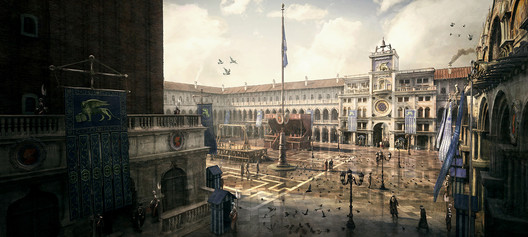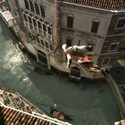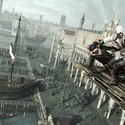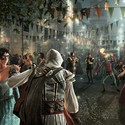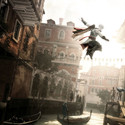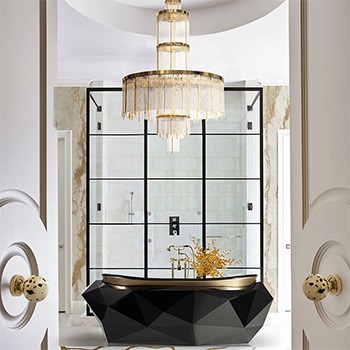By Manuel Saga
In the following article, originally published in Spanish on MetaSpace as “Assassin’s Creed 2 – Arquitectos que hacen videojuegos“(Architects Who Make Video Games), Spanish architect Manuel Saga interviews fellow Spaniard María Elisa Navarro, a Professor of Architectural History and Theory, who worked with Ubisoft Montreal as a historical consultant on the design team for the video game Assassin’s Creed II, from the first rough drafts up to its launch in November of 2009.
While getting her PhD at McGill, María Elisa Navarro was a consultant for the entire development process of the game as part of a research project between the university and Ubisoft Montreal. She worked on the project in complete secrecy with “a small team of 20 people and then later more than 400 in a huge basement in Montreal.” Navarro worked on everything from late 15th century wardrobes to the correction of architectural errors in the recreated cities, going over the look and ornamental details of the buildings.
“Sometimes, for gameplay purposes, they needed to have walls with a lot of texture so that Ezio could climb them, but when the time came to lay those parts out, there were some inaccuracies. For example, I remember a balcony with a wrought iron railing that couldn’t have existed in that time period. I was responsible for detecting those issues,” Navarro noted in her conversation with MetaSpace.
Read the full interview with Navarro after the break.
María Elisa Navarro is an architect, a graduate of the Facultad de Arquitectura y Diseño de la Universidad de Los Andes class of 1999, where she later returned to work as a professor in January of 2014. During those 15 years, she continued her education with a Masters and a PhD from McGill University in Montreal, where she was able to personally work with the architect Alberto Pérez-Gomez, as well as with other important people in the field.
But that’s a story for another time, today, María Elisa is going to talk to us about her experience at Ubisoft Montreal, one of the most important developing studios in the world of video games. We’ll talk more about them later when we discuss their game Child of Light and the development of the Ubiart Framework Engine, but today we’re going to focus on one of their most successful titles: Assassin’s Creed II.
In Assassin’s Creed II we assume the role of Ezio Auditore da Firenze, a Florentine assassin during the Italian Renaissance, whose story takes place under the reign of Pope Alexander VI, and takes numerous elements that are typical of the Renaissance in order to create a storyline where we interact with characters like Machiavelli or Leonardo da Vinci. It is a sandbox style game, with an open world environment, where we’re able to move around as we please through cities like Florence, Venice or San Gimignano.

Manuel Saga (MS): What was your experience with video games before working at Ubisoft?
María Elisa Navarro (MEN): I had barely played Atari games, I’ve never been a video game fan. As a matter of fact, I personally have never even played Assassin’s Creed, it’s too difficult for me to get used to the controls. I have seen it being played a lot, since I was alongside the designers while they played so that they could explain to me the parts they were working on.
MS: How did you first come into contact with Ubisoft Montreal?
MEN: When I was living in Montreal I met, completely by chance, some French friends who worked at Ubisoft. They became part of my group of friends, the people who made up my social life outside of university. One of them, Vincent Gaigneux, was the Art Designer who was in charge of designing the main character (Editor’s note: Gaigneux is currently the Senior Art Designer at Ubisoft and has worked on all the important Assassin’s Creed titles). He asked me how he could familiarize himself with things like weapons, costumes, etc so that he could design them. I told him how to access the archives to study documents and original paintings from the time period, but the task was so foreign to him that they decided to arrange a meeting for me with the project manager. That was in February of 2008.
They offered to collaborate with McGill and begin a research project related to Assassin’s Creed II, on the condition that I be in charge of it. And that is how I ended up working at the company for two years — first advising a small team of 20 people and then later more than 400 in a huge basement in Montreal, collaborating with offices in Shanghai. It was a secret project, I couldn’t tell anyone what I was working on, and during the final stages the meeting was in a big basement with a controlled entrance, security cards, etc.

MS: What exactly did your job consist of?
MEN: Ubisoft needed to become familiar with the time period between 1476 and 1503, both for character design, and for the 3D modeling and gameplay design. I prepared a kind of master class for them where I presented, for example, the history of the House of Medici and of Girolamo Savonarola. I also prepared documents from the archives and databases at McGill, responding to the different design needs.
MS: What are some specific aspects we can see represented in the game? What do you think the players feel about it?
MEN: For example, one of the first of these kinds of documents was a list of buildings we can find in modern day Venice that also existed back then, like churches. This is a piece of interesting information, because they didn’t begin constructing the Renaissance facades until much later, so I showed them the example of San Lorenzo (that never had this type of facade) so they could imagine how the churches would have been at that time and create their designs accordingly.
One special moment was when they needed a city apart from the main ones, to put a section of the game that had a large amount of towers and high spaces. I started researching and together we came to the conclusion that this part of the story would take place in San Gimignano.
Another aspect we dealt with was the look of the buildings — they were modeling, and I would meet with them periodically to verify the accuracy of the historical reconstruction. Sometimes, for gameplay purposes, they needed to have walls with a lot of texture so that Ezio could climb them, but when the time came to lay those parts out, there were some inaccuracies. For example, I remember a balcony with a wrought iron railing that couldn’t have existed in that time period. I was responsible for detecting those issues.
On the other hand, late 15th century buildings most likely had only one level, two maximum, but they decided to ignore that fact for the sake of gameplay.

MS: That is an interesting point. The urban and architectural space is based on reality, but it is a fantasy designed to tell a story and provide an experience in the same way a script respects some historical facts and modifies others. It works in a similar manner to literature or cinema.
MEN: Yes. They tried to make it so that each decision to deviate from historical accuracy was always done with some part of the game in mind.
MS: What other aspects did your work influence, beyond the architecture?
MEN: One example would be the wardrobe. I would have never imagined that the clothing could be so different between Florence and Venice. To document that I had to base a lot off of the paintings of that time period, studying them in great detail to detect the particular differences. For example, the cities had different laws about the kind of neckline women were allowed to wear. In Venice the laws were more lax, and that’s where the courtesan character shows up. None the less, the noblewomen weren’t allowed to go into the streets uncovered in Venice or in Florence. In Florence the men wore a unique hat, while in Venice they didn’t, etc.
Another thing was the hairstyles, that we studied through artists like Botticelli. For example, the ideal beauty in Venice was the blonde woman, so many women dyed their hair. Apart from those more general types of jobs, there was a questionnaire that the artists could fill out to ask me more specific things. All of that appeared in the game.

MS: What was a typical meeting like?
MEN: My direct contact was producer Genevieve Dufour — the woman I met with the most.
MS: Were there a lot of women in Ubisoft?
MEN: Not at all, we worked completely surrounded by men. We were very very few women at Ubisoft, to the point of it being uncomfortable. Imagine a proportion of a hundred to one.
MS: Wow!
MEN: Yes, apart from meetings with the producer, I had a lot of work sessions with Vincent Gaigneux and his teammates. They were in charge of the concept art, both of the characters and their surroundings, that is to say, they made drawings that were transformed and served as a base for the 3D modeling. They showed me their work in Photoshop and we modified it together. Later, I also met with the 3D artists. They would play so that I could verify the design, say if there were any changes that needed to be made, etc.
MS: Your job was always like that for the whole two years?
MEN: After the first meetings, I went on to assist the artists and modelers. From there, my time increased little by little, from only one weekly meeting to three or four. Later, when the project was already very established, we went to the high security basement that I mentioned earlier, and there I worked on the cinematic cutscenes.
Yves Simoneau, the director, arranged a two hour meeting for me where I responded to a barrage of questions. I remember that there were a lot of doubts about the interiors and the furniture, about how they imagined the Papal Apartments to be. It was all pre-filming work, for drawings and models of the environment.

MS: One question people are sure to ask, were there other architects on the team?
MEN: Not that I know of. There were conceptual artists and 3D modelers that were specialized in architecture. They were professionals with a very specific technical education, a special type of degree.
MS: What would you say is your takeaway from this experience? How has your way of seeing video games changed?
MEN: For me the most interesting thing about the experience was the historical interest in the development of a video game. The genuine concern on their part was a pleasant surprise. What’s more, it seems like an excellent way to spread information that is normally quite hidden. In fact, compiling the information was half of my job for two years, so it seems to me an excellent way to make sure that knowledge doesn’t stay hidden. It represents another form of learning.
Personally, I learned a lot, not only about history but also about how the video game industry works. In the specific case of Assassin’s Creed II the development was more artistically oriented rather than technologically. I remember that each main character could easily take up a year’s worth of work.
Truthfully the primary part of my job wasn’t anything sexy; looking for documents, compiling them, scanning them… They were all sent in really plain Word documents. However, for them the documents were a vital resource that allowed them to make a very realistic experience, truly beautiful.
For me it was a pleasure to work on a creation that mixes such a young industry, with the oldest in the world, history.
MS: Have you gone back to work on any of the other Assassin’s Creeds?
MEN: No. It was a one-time job, the company didn’t want to be tied to me nor me to them. Later on I worked with Alberto Pérez Gómez on other projects related to video games, with a completely different focus, but we’ll save that story for another time.





